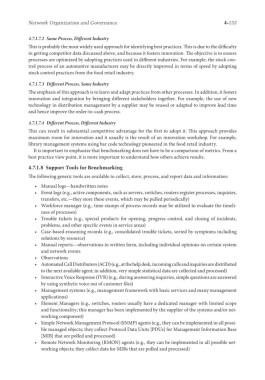Page 602 - Handbook of Modern Telecommunications
P. 602
Network Organization and Governance 4-133
4.7.1.7.2 Same Process, Different Industry
This is probably the most widely used approach for identifying best practices. This is due to the difficulty
in getting competitor data discussed above, and because it fosters innovation. The objective is to ensure
processes are optimized by adopting practices used in different industries. For example, the stock con-
trol process of an automotive manufacturer may be directly improved in terms of speed by adopting
stock control practices from the food retail industry.
4.7.1.7.3 Different Process, Same Industry
The emphasis of this approach is to learn and adapt practices from other processes. In addition, it fosters
innovation and integration by bringing different stakeholders together. For example, the use of new
technology in distribution management by a supplier may be reused or adapted to improve lead time
and hence improve the order-to-cash process.
4.7.1.7.4 Different Process, Different Industry
This can result in substantial competitive advantage for the first to adopt it. This approach provides
maximum room for innovation and it usually is the result of an innovation workshop. For example,
library management systems using bar code technology pioneered in the food retail industry.
It is important to emphasize that benchmarking does not have to be a comparison of metrics. From a
best practice view point, it is more important to understand how others achieve results.
4.7.1.8 Support Tools for Benchmarking
The following generic tools are available to collect, store, process, and report data and information:
• Manual logs—handwritten notes
• Event logs (e.g., active components, such as servers, switches, routers register processes, inquiries,
transfers, etc.—they store these events, which may be pulled periodically)
• Workforce manager (e.g., time stamps of process records may be utilized to evaluate the timeli-
ness of processes)
• Trouble tickets (e.g., special products for opening, progress control, and closing of incidents,
problems, and other specific events in service areas)
• Case-based-reasoning records (e.g., consolidated trouble tickets, sorted by symptoms including
solutions by resource)
• Manual reports—observations in written form, including individual opinions on certain system
and network events
• Observations
• Automated Call Distributors (ACD) (e.g., at the help desk, incoming calls and inquiries are distributed
to the next available agent; in addition, very simple statistical data are collected and processed)
• Interactive Voice Response (IVR) (e.g., during answering inquiries, simple questions are answered
by using synthetic voice out of customer files)
• Management systems (e.g., management framework with basic services and many management
applications)
• Element Managers (e.g., switches, routers usually have a dedicated manager with limited scope
and functionality; this manager has been implemented by the supplier of the systems and/or net-
working component)
• Simple Network Management Protocol (SNMP) agents (e.g., they can be implemented in all possi-
ble managed objects; they collect Protocol Data Units [PDUs] for Management Information Base
[MIB] that are polled and processed)
• Remote Network Monitoring (RMON) agents (e.g., they can be implemented in all possible net-
working objects; they collect data for MIBs that are polled and processed)

